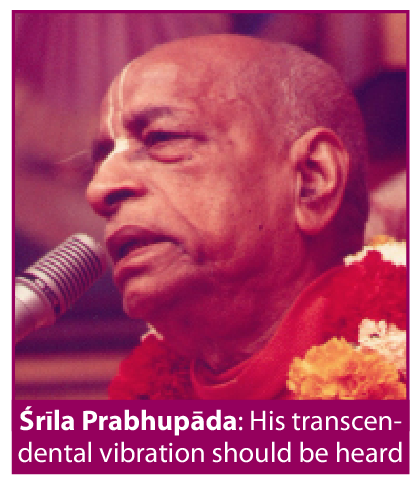
Back To Prabhupada, Issue 48, Summer 2015
n previous issues, we have covered the many desperate attempts to argue that the diksa guru must be "living", i.e. physically present. These arguments can basically all be defeated simply by stating two obvious facts:
a) Many of Srila Prabhupada's disciples never had any physical contact with him.
b) Nearly all of the "physically present" gurus whom we must supposedly accept because a "physically present" guru is supposedly essential, do not in any case themselves have a "physically" present guru!
In addition, we have noted the most important and relevant fact -- that Srila Prabhupada never taught that the diksa guru must be physically present, and on the contrary has taught the opposite. Yet, certain quotes have frequently been misused to falsely claim that Srila Prabhupada does preach the need for a physically present diksa guru. We examine one such quote here. All emphases added.
The following quote is claimed to be "evidence" that hearing from Srila Prabhupada will not help, and instead one must approach a "living" (physically present) person:
"A gramophone will not help. [...] "If you want to read Srimad-Bhagavatam, you must approach a person who is life living Bhagavata.""
(Srila Prabhupada Lecture, 27/5/74)
On first reading, the quote may appear to support this false conclusion: a "gramophone" will not help us; rather, if we want to read the Srimad-Bhagavatam, we must approach a "living" person. Thus, supposedly, we cannot rely on Srila Prabhupada's recorded or written words but instead we must approach a physically present person. However, let us examine this quote closely.
The version of the quote presented above is a truncated version used to make the case for the "living" guru theory. The full quote actually states:
"Therefore there are many, many very artistic Bhagavata reciters, but they could not turn even one man to Krsna consciousness. Because they are not self-realized, svanubhavam. Of course, we have tried our best; so in few years there are so many Krsna conscious persons come out. This is the secret. Unless one is svanubhavam, self-realized, life is bhagavata, he cannot preach Bhagavata. That is not... That will not be effective. A gramophone will not help. Therefore Caitanya Mahaprabhu's secretary, Svarupa Damodara, recommended, bhagavata pora giya bhagavata-sthane, that "If you want to read Srimad-Bhagavatam, you must approach a person who is life living Bhagavata."
(Srila Prabhupada Lecture, 27/5/74)
1) It states "That will not be effective. A gramophone will not help". The "not help" part referring to the "gramophone" repeats the "will not be effective" statement just made. Hence the "gramophone" refers to whatever the "that" which "will not be effective" refers to.
2) To determine what the "that" refers to, we need to read the statements before the "That will not be effective" part. And we can see that the "that" refers to "artistic Bhagavata reciters" rather than a self-realized person. Thus, the "gramophone" here does not refer to the preaching of Srila Prabhupada which may have been recorded, but the presentations of non-self-realised Bhagavata reciters.
3) The phrase "life living bhagavata" is used to mean one whose "life is bhagavata". That is, the "living" part is used to describe a self-realised person who is a "living" Bhagavata. It is not used to refer to someone who must be "physically present". Nor does the quote state that such a person must be physically present in order to be approached, nor that his preaching cannot be received in a recorded form. Thus, the quote actually states that we approach Srila Prabhupada, as he is a self-realised person, with a life as a "living Bhagavata", and not an "artistic Bhagavata reciter".
Srila Prabhupada states this same understanding -- that "gramophone" refers specifically to hearing from a non-realised person -- repeatedly:
"Gramophone or tape record speaker, that will not be. You must be live speaker. Your living condition should be spiritually, what is called, surcharged. [...] When you are spiritually strong, if you speak something on spiritual subject matter, then it will be effective. Otherwise it will be just like tape record playing."
(Srila Prabhupada, Room Conversation, 5/10/75)
"But if you want to manufacture something of your own concoction, that will not act. That will not... That will be gramophone."
(Srila Prabhupada Lecture, 6/12/73)
"But who is chanting, he must be a sincere devotee. Then his chanting will be effective. A gramophone machine will not do. He must be realized; then his chanting will be effective."
(Srila Prabhupada, Room Conversation, 3/8/76)
Thus, Srila Prabhupada specifically uses "gramophone" to refer to the concocted preaching of a non-realised person as being just like mechanical words coming from a machine, as opposed to the "spiritually surcharged" preaching that comes from one who is a realised person.

The self-realised sound vibration from Srila Prabhupada is transcendental and can continue to be received via a recording:
"I have also accepted, upon your recommendation, the five men for 2nd initiation. Let them hear the gayatri mantra through the right ear from the tape of myself chanting it."
(Srila Prabhupada Letter, 6/2/75)
"The transcendental vibration from the mouth of a pure devotee is so powerful that it can revive the living entity's memory of his eternal relationship with the Supreme Personality of Godhead."
(SB, 4.20.25)
"The potency of transcendental sound is never minimized because the vibrator is apparently absent."
(SB, 2.9.8)
1) The rejection of the teaching of non-realised professional Bhagavatam reciters does not refer to rejecting the continued acceptance of the transcendental teaching of the self-realised "living Bhagavata", Srila Prabhupada.
2) This self-realised teaching can continue to be received in recorded or written form.
3) This is a case study in how being motivated by the "living guru" theory leads one to see what one wants to see, rather than what is actually there.
Return to IRM Homepage